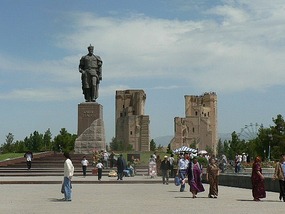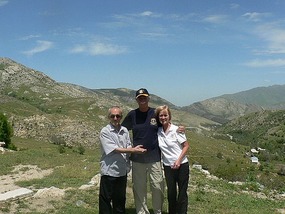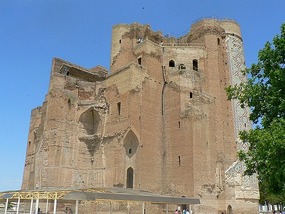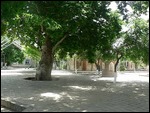South of Samarkand in the hills of Kashka-Darya Province lies the charming small Uzbek township of Shakhrisabz. It is indeed the home of the great Tamerlame (Emir Timur) and it is one of the oldest cities in the world. Even the troops of Alexander the Great rested here on their travels. And although Tamerlame had made Samarkand his capital city, he always thought of Shakhrisabz as his home, even planning to be buried there. Tamerlame is certainly a great symbolic figure in Uzbekistan. With an army in excess of 100,000 and an empire stretching from Kashgar in west China to Egypt, we often wondered about the logistics of organising and mobilising an army of that size in those days.
Today Shakhrisabz has a population of 75,000 and is home to some of the most awesome ancient ruins of some of the great Tamerlane's most ambitious architectural projects
.
The ninety kilometer trip from Samarkand to Shakhrisabz was very pleasant. Muxim was our guide for the day and like our other guides was very serious and informative about his work and the history of the region. The country we passed through on our way was lush and fertile looking with some wheat being harvested by hand scythe, mostly by women. We then climbed up a narrow road across hills with pretty apricot and mulberry orchards dotted between willows and poplar trees. Local street stalls sold fresh fruit, rhubarb, dried yoghurt, dried fruits and nuts. Cattle, donkeys and sheep leisurely wandered across and around the roads.
The road climbed up further into mountainous country over the 1,788 m Takhtakaracha Pass with wonderful views of the Shakhrisabz valley and interspersed with fabulous rocky granite outcrops. The Fan Mountains forming a border with Tajikistan were visible in the distance. With such a pleasant drive we started to feel well again
.
The township of Shakhrisabz in its valley location was unbelievably hot. It was one of the most interesting visits we had. On entering the township we were immediately confronted by a huge bronze statue of Tamerlame and behind the extraordinary ruins of Ak-Saray, Tamerlame's summer palace. It seems that everything Tamerlame did was big. The crumbling ruins reveal the remains of a colossal building that began to be built in 1380 and using local white marble took some 24 years to complete. Apparently the original arch of this building had a span of more than 22 m. Although there is not much of this building remaining, it is still possible to see the gorgeous original filigree on the 50 m gates. Apparently the huge slabs of marble were moved by elephants which were transported here from India. Without cranes and modern equipment the creation of this building seemed almost unbelievable.
Devastatingly, the building was destroyed by a Bukhara Emir
. It was a shocking piece of history to us. How could it take two years to destroy a building that took 24 to build? It seems like humans just never learn from history.
Our visit to Shakhrisabz also took us to the Tomb of Tamerlame’s eldest and favourite son Jehangir who died aged just 22 years. It is also the tomb of another son, Umar Sheikh. The Lonely Planet describes the tomb as melancholy and it certainly was. We also explored the crypt that was built for Tamerlame but was not to be his final resting place. Tamerlame contracted pneumonia and died unexpectedly in Kazakhstan in the winter of 1405. The passes to Shakhrisabz were snowed in and so he was buried in Samarkand.
In the afternoon we roamed around the Kok-Gumbaz Mosque. The architecture was beautiful and we were intrigued by the 1,000 year old plane tree. What a piece of history this tree must have seen.
Shakhrisabz was truly a special place, free of tourists and with wonderful atmosphere. We were sorry that we did not have more time to roam around the ruins on our own.
Shakhrisabz - Home of Tamerlane
Tuesday, May 26, 2009
 Tashkent, Uzbekistan
Tashkent, Uzbekistan
Other Entries
-
1From Crowdy Head to Sydney - Our Adventures Begin
May 1511 days prior Crowdy Head, Australiaphoto_camera0videocam 0comment 1
Crowdy Head, Australiaphoto_camera0videocam 0comment 1 -
2Sydney Airport - Well, Here we go Again!
May 1610 days prior Sydney, NSW, Australiaphoto_camera2videocam 0comment 0
Sydney, NSW, Australiaphoto_camera2videocam 0comment 0 -
3Our Beloved Shanghai Again
May 1610 days prior Shanghai, Chinaphoto_camera8videocam 0comment 0
Shanghai, Chinaphoto_camera8videocam 0comment 0 -
4Across China to the Far City of Urumqi
May 197 days prior Urumqi, Chinaphoto_camera7videocam 0comment 0
Urumqi, Chinaphoto_camera7videocam 0comment 0 -
5Tashkent - A Lesson in Uzbekistan Bureaucracy!
May 206 days prior Tashkent, Uzbekistanphoto_camera12videocam 0comment 1
Tashkent, Uzbekistanphoto_camera12videocam 0comment 1 -
6From Tashkent to the Historic City of Khiva
May 215 days prior Khiva, Uzbekistanphoto_camera9videocam 0comment 1
Khiva, Uzbekistanphoto_camera9videocam 0comment 1 -
7Across the Kyzylkum Desert to Bukhara
May 224 days prior Bukhara, Uzbekistanphoto_camera6videocam 0comment 0
Bukhara, Uzbekistanphoto_camera6videocam 0comment 0 -
8Our Stay In the Beautiful City of Bukhara
May 233 days prior Bukhara, Uzbekistanphoto_camera8videocam 0comment 0
Bukhara, Uzbekistanphoto_camera8videocam 0comment 0 -
9Day One in The Romantic and Fascinating Samarkand
May 251 day prior Samarkand, Uzbekistanphoto_camera8videocam 0comment 1
Samarkand, Uzbekistanphoto_camera8videocam 0comment 1 -
10Shakhrisabz - Home of Tamerlane
May 26 Tashkent, Uzbekistanphoto_camera5videocam 0comment 0
Tashkent, Uzbekistanphoto_camera5videocam 0comment 0 -
11Our Tour of Samarkand
May 271 day later Samarkand, Uzbekistanphoto_camera8videocam 0comment 0
Samarkand, Uzbekistanphoto_camera8videocam 0comment 0 -
12From Samarkand to Tashkent
May 282 days later Tashkent, Uzbekistanphoto_camera0videocam 0comment 0
Tashkent, Uzbekistanphoto_camera0videocam 0comment 0 -
13Tashkent to Bishkek, Kyrgyzstan
May 293 days later Bishkek, Kyrgyzstanphoto_camera0videocam 0comment 0
Bishkek, Kyrgyzstanphoto_camera0videocam 0comment 0 -
14Our Introduction to Kyrgyzstan
May 293 days later Bishkek, Kyrgyzstanphoto_camera5videocam 0comment 0
Bishkek, Kyrgyzstanphoto_camera5videocam 0comment 0 -
15From Bishkek to Lake Issykul
May 304 days later Issykul, Kyrgyzstanphoto_camera7videocam 0comment 0
Issykul, Kyrgyzstanphoto_camera7videocam 0comment 0 -
16Issykul to Kochkor
May 315 days later Kochkor , Kyrgyzstanphoto_camera12videocam 0comment 0
Kochkor , Kyrgyzstanphoto_camera12videocam 0comment 0 -
17From Kochkor to Tash Rabat
Jun 016 days later Tash Rabat, Kyrgyzstanphoto_camera11videocam 0comment 0
Tash Rabat, Kyrgyzstanphoto_camera11videocam 0comment 0 -
18From Tash Rabat to the Torugat Pass and Into China
Jun 027 days later Kashgar, Chinaphoto_camera9videocam 0comment 0
Kashgar, Chinaphoto_camera9videocam 0comment 0 -
19Over the Torugat Pass and onto Kashgar
Jun 027 days later Kashgar, Chinaphoto_camera0videocam 0comment 0
Kashgar, Chinaphoto_camera0videocam 0comment 0 -
20Cashless in Kashgar
Jun 027 days later Kashgar, Chinaphoto_camera6videocam 0comment 0
Kashgar, Chinaphoto_camera6videocam 0comment 0 -
21Down the Karakoram Highway Once Again
Jun 038 days later Tashkurgan, Chinaphoto_camera8videocam 0comment 0
Tashkurgan, Chinaphoto_camera8videocam 0comment 0 -
22Two Blissful Days In Tashkorgan
Jun 038 days later Tashkorgan, China, Pakistanphoto_camera13videocam 0comment 3
Tashkorgan, China, Pakistanphoto_camera13videocam 0comment 3 -
23Over the Khunjerab Pass and Into Pakistan
Jun 0510 days later Passu, Pakistanphoto_camera7videocam 0comment 0
Passu, Pakistanphoto_camera7videocam 0comment 0 -
24Our Introduction to Pakistan
Jun 0611 days later Passu, Pakistanphoto_camera5videocam 0comment 0
Passu, Pakistanphoto_camera5videocam 0comment 0 -
25Welcome to the Jeep Road to the Shimshal Valley
Jun 0611 days later Shimshal Valley, Pakistanphoto_camera6videocam 0comment 2
Shimshal Valley, Pakistanphoto_camera6videocam 0comment 2 -
26Our Stay In Gulmit and Visit to Gulkhin
Jun 0712 days later Gulmit, Pakistanphoto_camera6videocam 0comment 2
Gulmit, Pakistanphoto_camera6videocam 0comment 2 -
27We Find Heaven at the Eagle's Nest Hotel, Duikar
Jun 0813 days later Duikar, Northern Areas, Pakistanphoto_camera4videocam 0comment 8
Duikar, Northern Areas, Pakistanphoto_camera4videocam 0comment 8 -
28The Lovely Karimabad and the Hunza Valley
Jun 1015 days later Karīmābād, Pakistanphoto_camera3videocam 0comment 2
Karīmābād, Pakistanphoto_camera3videocam 0comment 2

 Tashkent, Uzbekistan
Tashkent, Uzbekistan









2025-05-23